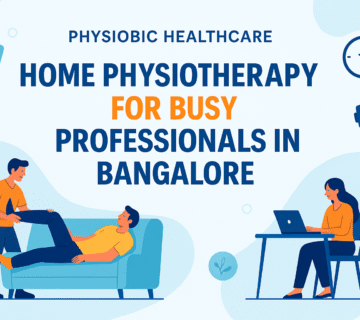Introduction
Sciatica is a prevalent condition characterized by pain radiating along the path of the sciatic nerve, which extends from the lower back through the hips and buttocks and down each leg. This condition often manifests as a sharp or burning pain, typically affecting one side of the body. Sciatica can be debilitating, impacting daily activities and overall quality of life. However, physiotherapy has proven to be an effective treatment option. In bustling urban areas like Bangalore, home physiotherapy services—such as those provided by Physiobic Healthcare—offer a convenient and personalized approach to managing sciatica.
Understanding Sciatica
Sciatica occurs when the sciatic nerve is compressed or irritated, often due to conditions such as herniated discs, spinal stenosis, or piriformis syndrome. The pain can vary from mild discomfort to debilitating agony, often accompanied by symptoms like numbness, tingling, or weakness in the leg.
Common Causes of Sciatica
- Herniated Discs: The most common cause, where the soft inner material of a spinal disc protrudes, compressing nearby nerves.
- Spinal Stenosis: A narrowing of the spinal canal that can put pressure on the nerve roots.
- Piriformis Syndrome: When the piriformis muscle in the buttocks spasms, it can irritate the sciatic nerve.
- Spondylolisthesis: A condition where one vertebra slips over another, causing nerve compression.
Symptoms of Sciatica
Recognizing the symptoms of sciatica is crucial for early intervention:
- Pain: Typically felt on one side of the body, the pain can be sharp, burning, or shooting in nature.
- Numbness: Patients often report a tingling or numb sensation in the leg or foot.
- Weakness: There may be difficulty in moving the affected leg or foot.
- Worsening Symptoms: Pain may intensify when sitting, standing, or making specific movements.
The Role of Physiotherapy in Managing Sciatica
Physiotherapy plays a critical role in the management of sciatica. A qualified physiotherapist will design a customized treatment plan to address the patient’s specific needs, focusing on pain relief and restoring mobility.
Goals of Physiotherapy for Sciatica
- Pain Relief: Using various techniques to reduce discomfort and inflammation.
- Restoration of Mobility: Enhancing the range of motion and flexibility in the lower back and legs.
- Strengthening Exercises: Focusing on building strength in the core and lower body to support the spine.
- Education: Teaching patients about posture, body mechanics, and lifestyle modifications to prevent recurrence.
Home Physiotherapy Services
For individuals suffering from sciatica, home physiotherapy services provide significant advantages. Here’s how Physiobic Healthcare can help:
- Convenience: Eliminating the need to travel is particularly beneficial for those in pain or with mobility issues.
- Personalized Care: One-on-one attention allows for tailored treatment that addresses individual concerns.
- Comfort of Home: Engaging in exercises in a familiar environment can enhance relaxation and motivation.
Physiobic Healthcare: Leading the Way in Home Physiotherapy
Physiobic Healthcare is committed to delivering comprehensive home physiotherapy services in Bangalore. Their team of experienced physiotherapists is dedicated to effective treatment for sciatica and other musculoskeletal conditions.
Services Offered
- Initial Assessment: A thorough evaluation to understand the patient’s condition and create a tailored treatment plan.
- Manual Therapy: Techniques to manipulate muscles and joints, relieving pain and improving function.
- Exercise Therapy: Customized exercise programs focusing on strengthening, stretching, and restoring mobility.
- Posture Training: Guidance on maintaining proper posture to alleviate stress on the sciatic nerve.
- Education and Support: Providing patients with knowledge and resources to manage their condition independently.
Treatment Techniques for Sciatica
1. Stretching Exercises
Stretching is crucial for relieving tension in the muscles surrounding the sciatic nerve. Some effective stretches include:
- Piriformis Stretch: Lie on your back, cross the affected leg over the opposite knee, and gently pull the knee toward your chest.
- Hamstring Stretch: Sit on the floor with one leg extended; reach toward your toes to stretch the hamstring.
- Knee-to-Chest Stretch: While lying on your back, bring one knee up toward your chest, holding for 20-30 seconds.
2. Strengthening Exercises
Strengthening the core and lower back muscles is essential for long-term relief. Recommended exercises include:
- Bridges: Lying on your back with knees bent, lift your hips to form a straight line from your shoulders to your knees.
- Planks: Position yourself on your elbows and toes, maintaining a straight line from head to heels to engage the core.
- Clamshells: Lying on your side with knees bent, open and close your top knee while keeping your feet together.
3. Manual Therapy Techniques
Manual therapy can help relieve pain and improve movement. Techniques include:
- Joint Mobilization: Gentle movements of the joints to increase mobility and decrease stiffness.
- Soft Tissue Massage: Reduces muscle tension and promotes blood flow, aiding in recovery.
Additional Modalities in Physiotherapy
In addition to exercises and manual therapy, several other modalities can enhance the treatment of sciatica:
- Ultrasound Therapy: This technique uses sound waves to promote tissue healing and reduce inflammation.
- Electrical Stimulation: Transcutaneous electrical nerve stimulation (TENS) can help alleviate pain by disrupting pain signals.
- Heat and Cold Therapy: Applying heat can soothe tight muscles, while ice can reduce swelling and inflammation.
Tips for Managing Sciatica at Home
In addition to physiotherapy, patients can implement various self-care strategies to manage their symptoms effectively:
- Heat and Ice Therapy: Alternate between heat and ice packs to reduce pain and inflammation. Apply heat for 15-20 minutes, followed by ice for the same duration.
- Maintain Good Posture: Be mindful of posture during daily activities, especially when sitting for extended periods. Use ergonomic chairs and supportive cushions.
- Stay Active: Engage in low-impact activities like walking, swimming, or cycling to keep muscles active without overexerting.
- Weight Management: Maintaining a healthy weight reduces stress on the spine and can alleviate symptoms.
- Mindfulness and Relaxation Techniques: Incorporate practices like yoga, meditation, or deep breathing to help manage pain and reduce stress.
Importance of Patient Education
Educating patients about their condition is a vital component of effective treatment. Physiobic Healthcare emphasizes the importance of understanding the nature of sciatica, its causes, and preventive measures. By empowering patients with knowledge, they are more likely to engage in their treatment actively and adhere to prescribed exercises.
Case Studies and Testimonials
Sharing success stories can inspire and encourage those struggling with sciatica. Here are a couple of testimonials from patients who benefited from home physiotherapy services:
- Ravi S.: “After months of suffering from sciatica, I was referred to Physiobic Healthcare. The physiotherapist conducted a thorough assessment and designed a personalized exercise program. I noticed significant improvements within a few weeks, and being treated at home made it so much easier.”
- Anita K.: “I was hesitant about home physiotherapy at first, but it turned out to be the best decision. The convenience of having a physiotherapist come to my home made all the difference. I learned effective stretches and exercises that have helped me manage my pain.”
Conclusion
Sciatica can significantly impact quality of life, but effective management is possible through home physiotherapy services like those offered by Physiobic Healthcare in Bangalore. By focusing on personalized care, education, and practical exercises, patients can alleviate pain and improve mobility from the comfort of their homes.
Call to Action
If you’re suffering from sciatica and are interested in home physiotherapy services, contact Physiobic Healthcare today to schedule your initial assessment. Take your first step toward recovery and reclaim your life from pain.
Final Thoughts
Investing in your health is paramount. With the right support, resources, and commitment, managing sciatica is within your reach. Don’t let sciatica hold you back—embrace the path to recovery and enjoy a pain-free life.



